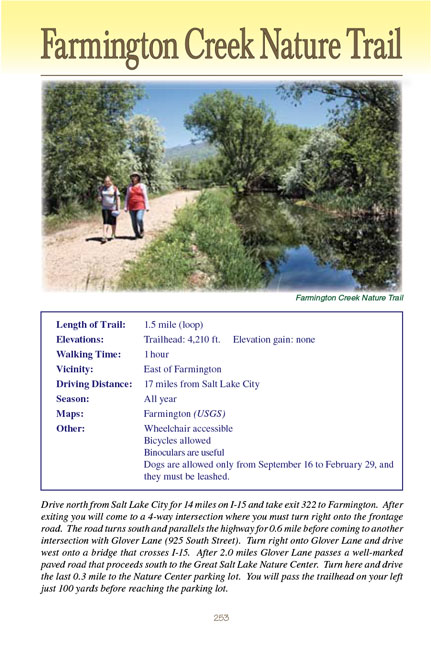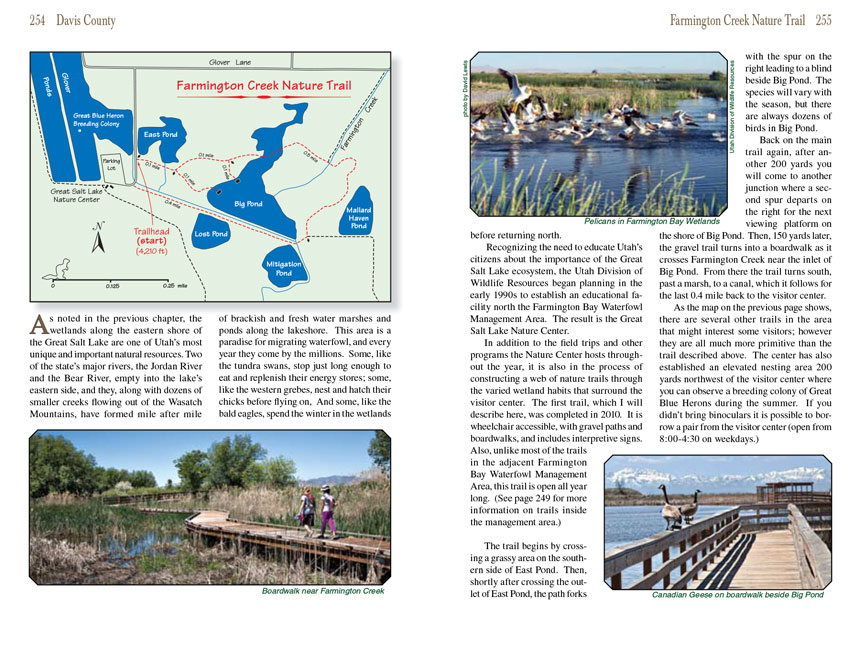Great Salt Lake Nature Trail
excerpted from our book
Salt Lake City's Incredible Hiking and Biking Trails
pages 253-255
|
Buy book directly from the author!
Salt Lake City's Incredible Hiking and Biking Trails
- has access info for 73 trailheads
- 73 colorful trail maps
- 325 full color photographs
- loads of hiking tips
|
regularly $19.95
now on sale for only
$9.95
click here
for book orders
|


As noted in the previous chapter, the wetlands along the eastern shore of the Great Salt Lake are one of Utahís most unique
and important natural resources. Two of the stateís major rivers, the Jordan River and the Bear River, empty into the lakeís eastern side, and they, along
with dozens of smaller creeks flowing out of the Wasatch Mountains, have formed mile after mile of brackish and fresh water marshes and ponds along the
lakeshore. This area is a paradise for migrating waterfowl, and every year they come by the millions. Some, like the tundra swans, stop just long enough
to eat and replenish their energy stores; some, like the western grebes, nest and hatch their chicks before flying on, And some, like the bald eagles,
spend the winter in the wetlands before returning north.
Recognizing the need to educate Utahís citizens about the importance of the Great Salt Lake ecosystem, the Utah Division of Wildlife Resources began planning
in the early 1990s to establish an educational facility north the Farmington Bay Waterfowl Management Area. The result
was the Great Salt Lake Nature Center.
In addition to the field trips and other programs the
Great Salt Lake Nature Center hosts throughout the year, it is also in the process of constructing a web of nature trails
through the varied wetland habits that surround the visitor center. The first trail, which I will describe here, was completed in 2010. It is wheelchair
accessible, with gravel paths and boardwalks, and includes interpretive signs. Also, unlike most of the trails in the adjacent Farmington Bay Waterfowl
Management Area, the Great Salt Lake Nature Center Trail is open all year long. (See page 249 for more information on trails inside the management area.)
The trail begins by crossing a grassy area on the southern side of East Pond. Then, shortly after crossing the outlet of East Pond, the path forks with the
spur on the right leading to a blind beside Big Pond. The species will vary with the season, but there are always dozens of birds in Big Pond.
Back on the main trail again, after another 200 yards
the Great Salt Lake Nature Center Trail comes to another junction where a second spur departs on the right for the next viewing platform
on the shore of Big Pond. Then, 150 yards later, the gravel trail turns into a boardwalk as it crosses Farmington Creek near the inlet of Big Pond. From
there the trail turns south, past a marsh, to a canal, which it follows for the last 0.4 mile back to the visitor center.
As the map on the previous page shows, there are several other trails in the area that might interest some visitors; however they are all much more primitive
than the trail described above. The Great Salt Lake Nature Center has also established an elevated nesting area 200 yards northwest of the visitor center where you can observe a
breeding colony of Great Blue Herons during the summer. If you didnít bring binoculars it is possible to borrow a pair from the visitor center (open from
8:00-4:30 on weekdays.)
Note to web developers: You may copy this material onto your site, but in return please include a link to my home page
www.utahtrails.com. Thank you, David Day (utahdavidday at gmail.com)
Click here to see more
trails near Salt Lake City
© Rincon Publishing Company, all rights reserved
|

